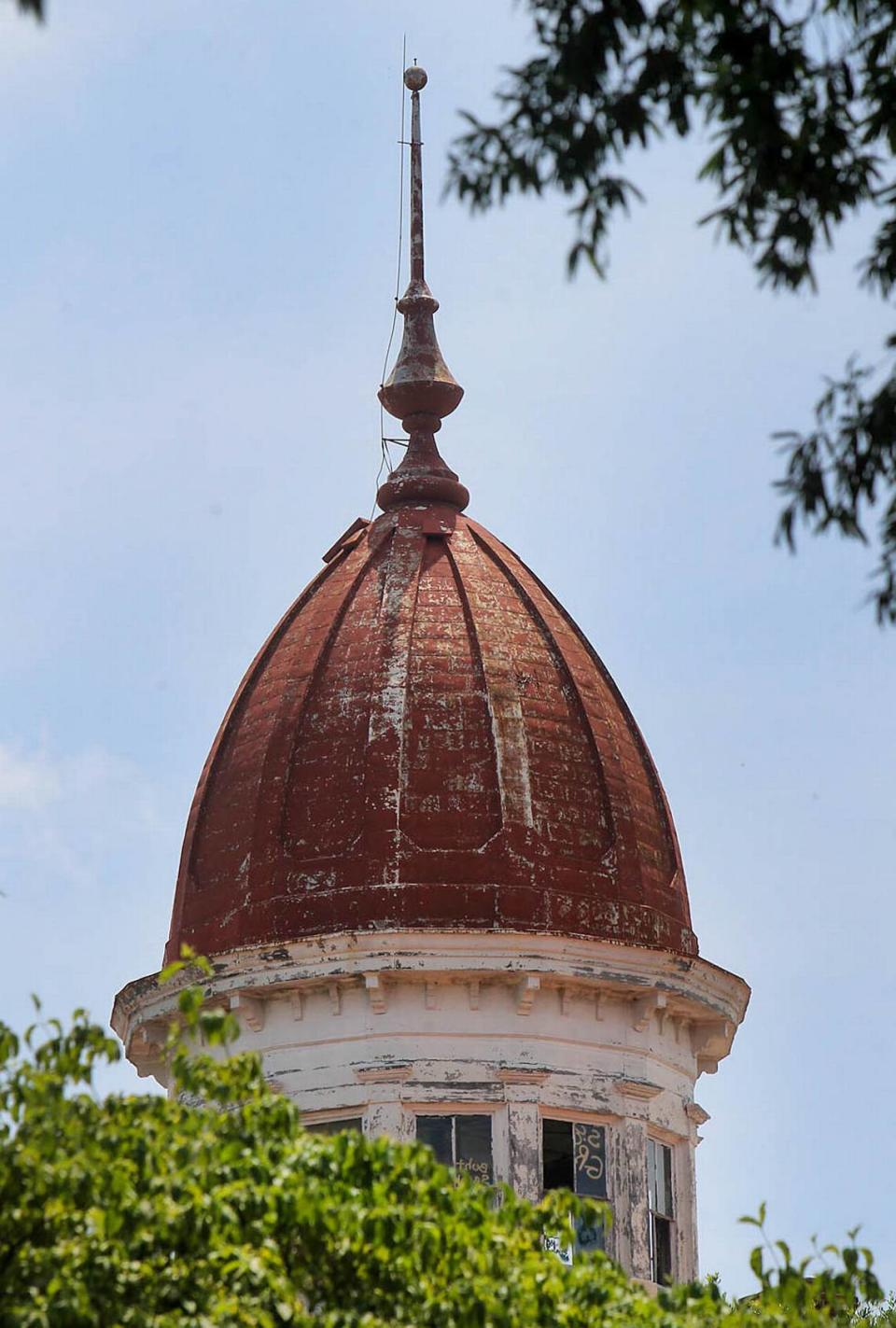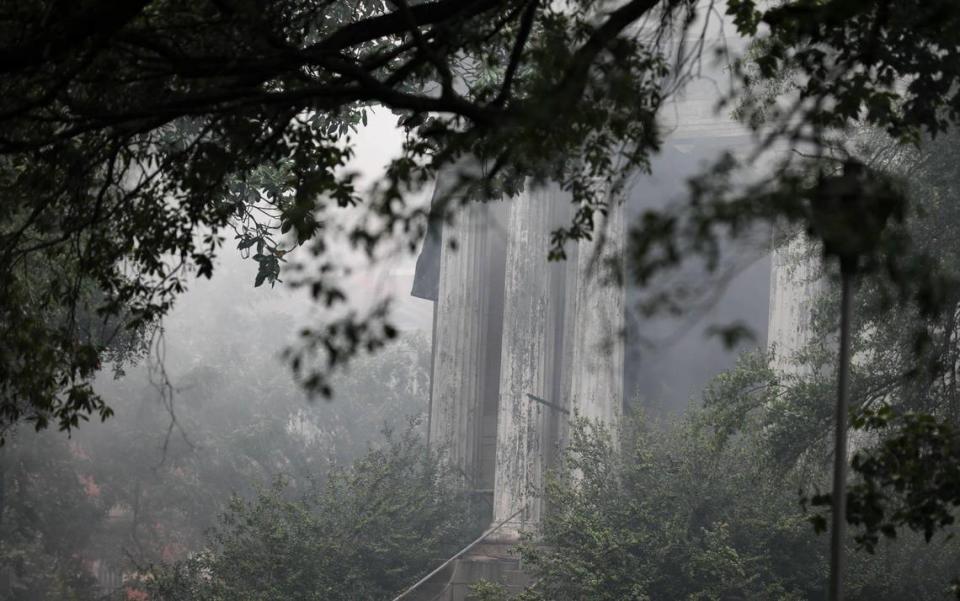Destroyed by fire, iconic Columbia dome is about to be replaced. Here’s how it happened
For over 150 years, the red-painted cupola on the roof of the Babcock Building joined with the State House to form a pair of iconic domes on Columbia’s skyline.
The cupola crowned the building as tens of thousands lived and worked at the State Hospital on Bull Street in the 19th and 20th centuries. It served as a landmark for anyone coming off of Interstates 26 and 77 into the city.
After standing abandoned since 1996, the Babcock’s cupola became the symbol of the BullStreet District redevelopment, promising the building and neighborhood would be a beacon for the city in the years to come.
Then came the fire in September 2020 that sent the cupola crashing to the ground floor of the Babcock Building. For the first time since 1885, the Babcock was without its iconic precipice.
The cupola is scheduled to make its return to Columbia’s skyline this summer in phases, with its base being installed on the roof Tuesday, July 25. With financial hurdles, fires and a pandemic, it’s a day many thought would never come.
A daunting task
The Babcock Building was the second to be built for the South Carolina Lunatic Asylum, later known as the South Carolina State Hospital, said Kat Allen, director of outreach and engagement for Historic Columbia. The building was built in phases, between 1857 and 1885. The central portion, featuring a cupola over the roof, was the last part of the building to be completed.
The hospital complex saw its last patients in 1991 and the Babcock became abandoned in 1996. For years redevelopment plans for the 181-acre campus swirled around, but the Babcock was often the dealbreaker, Hugh Shytle, president of the building’s current owner, Richmond-based Clachan Properties, said.
“We weren’t the first to look at it,” Shytle said. “We’re told that a number of groups that wanted to tour it (for potential development) would get 100 feet into the building and turn around. It was just a daunting task to figure out how you could save this building.”
In the years since it closed in 1996, the Babcock had been open to the elements, with broken windows, roofing failures and termites, Shytle said. There were also remnants of when the building was used as a filming location for “Death Sentence,” a 2007 Kevin Bacon movie, John Sherrer, director of preservation at Historic Columbia, said.
Despite being dilapidated, the central, cupola-capped portion of the Babcock had been added to the National Register of Historic Places in 1981, and couldn’t be torn down.

It was more than just the law motivating the owners to revitalize the building. During Clachan’s campaign to receive funding for the project, Shytle read passionate letters about the project from Columbia residents like former Mayor Steve Benjamin, touting the building’s significance to the city.
“I thought ‘oh my goodness, we’re not just doing a deal here. We’re doing something that’s important,’” Shytle said. “We’ve worked on deals and we’ve had a very successful career, but rarely do you get a chance to work on something important (like the Babcock Building).”
After spending millions buying the hospital campus from the state in 2010, Robert Hughes, president of BullStreet District developer Hughes Development Corporation, sold the Babcock Building to Clachan Properties for just $1 in 2019 to offset the high construction costs, Shytle said.
Even with the discount price for the 254,000-square-foot building, over four years passed before Clachan, which specializes in historic renovations, could acquire the federal and state tax credits to finance and start construction, Shytle said.
Workers had just begun clearing out the Babcock for construction in September 2020 when a fire gutted the central portion of the building.
The cupola, originally designed to help circulate air for hospital patients, acted as a chimney, channeling the fire and smoke up and out the top of the building, Sherrer said. During the hours-long blaze, the Babcock’s iconic crown, which had survived shaking from the 1886 Charleston earthquake and decades of neglect, collapsed into the heart of the building.
Between the robust construction of the building – with its 20-inch-thick masonry walls – and the actions of the Columbia Fire Department, the fire did not spread to other sections of the building and only damaged 10-15% of the overall square footage, Shytle said.
Even so, repairing the central portion of the building and the cupola would set back the project several months. And the city was missing a landmark.
“Initially people thought it was a total loss. It was anything but, but it’s a pretty dark, traumatic thing to have one of the most iconic facets of your city burn and collapse in upon the building,” Sherrer said.

FROM THE ASHES
Clachan Properties worried that enough of the historical character of the building had been destroyed by the fire that the restoration project would no longer receive certain federal funding, Shytle said. Had the building been destroyed, the land it sat on would have been worth millions, he said.
However, Clachan maintained its federal funding and committed within weeks of the fire to rebuilding the dome, Hughes said.
Construction began on the parts of the building that hadn’t been damaged: the first apartments got certificates of occupancy in December 2021, and 12 people moved in in early 2022 with an active construction site around them and most of the amenities not ready yet. And no cupola.
“One of the challenges with this building is we felt like we were in a race,” Shytle said. “Every day the building was getting more expensive to develop. If you didn’t stop the erosion, you were just gonna get to a point where you just couldn’t do it anymore.”
Other phases of the BullStreet District were completed, including the Segra Park minor league baseball stadium, businesses and other apartment buildings. Meanwhile, the Babcock cupola, still featured on the district’s logo, remained absent from the skyline.
That was due to another unexpected setback: the COVID-19 pandemic. The original builders of the new cupola couldn’t complete the structure because of supply chain issues, so Clachan decided to have the cupola built in three separate pieces – the base, the clerestory and the spire – by three different builders, Shytle said.
“The obvious quip is you don’t go to Lowe’s to get a cupola,” he said. “I mean, there’s only so many people that can build a cupola.”
The base is scheduled to be lifted onto the building on Tuesday, July 25, after traveling from a workshop in Texas, Shytle said. The clerestory, containing the windows, will come on Wednesday, July 26. The dome and spire will come from Indiana and are scheduled to be installed on Aug. 9 after a spire-signing ceremony with lawmakers and developers, he said.
“We had to scramble and spend a lot more money than we originally hoped to get it in place anywhere near the finish of construction,” he said. “So it’s been a doozy of a project, a real engineering effort to get one group of people to build the base and another group of people to build the dome and we’re just keeping our fingers crossed that the two fit together.”
The apartments in the central portion of the building, under the cupola and where the 2020 fire raged, will be the last to be opened for occupancy at the end of August, he said. The building has filled up quickly, with Columbia Fireflies players, longtime Columbia residents, new arrivals, technology and health care workers, taking residence in what will eventually be a total of 208 apartments.
“As fast as we can deliver them, people have wanted to live at the Babcock,” he said.
AN ICON RESTORED
Even after the cupola is restored and the Babcock renovation completed, there will still be more to complete in the BullStreet District, Hughes said. More residential units and retail will open and more historic structures such as the Williams Building will be restored before the district, with an estimated economic impact of $1.2 billion, will be complete.
But the return of the Babcock Building’s cupola will be a symbolic milestone for the project that many thought could never happen even before the fire, Hughes said.
“The building itself is such a symbol for the district, for the city and for the state,” he said. “I think that it’s hard to understate just the symbolism of that building. Before it was renovated, it really did cast a shadow across the entire district and now the cupola is really a beacon.”
But more than just a sign that another phase in the BullStreet development has come and gone, the new cupola will also mark the return of a Columbia icon.
“For too long now, you haven’t had both of your domes,” Shytle said. “I feel like we’re restoring the skyline and I’m really happy to be a part of that.”
“The first time we drive in on 26 and see that dome back there is gonna be a very special occasion,” Hughes said.

